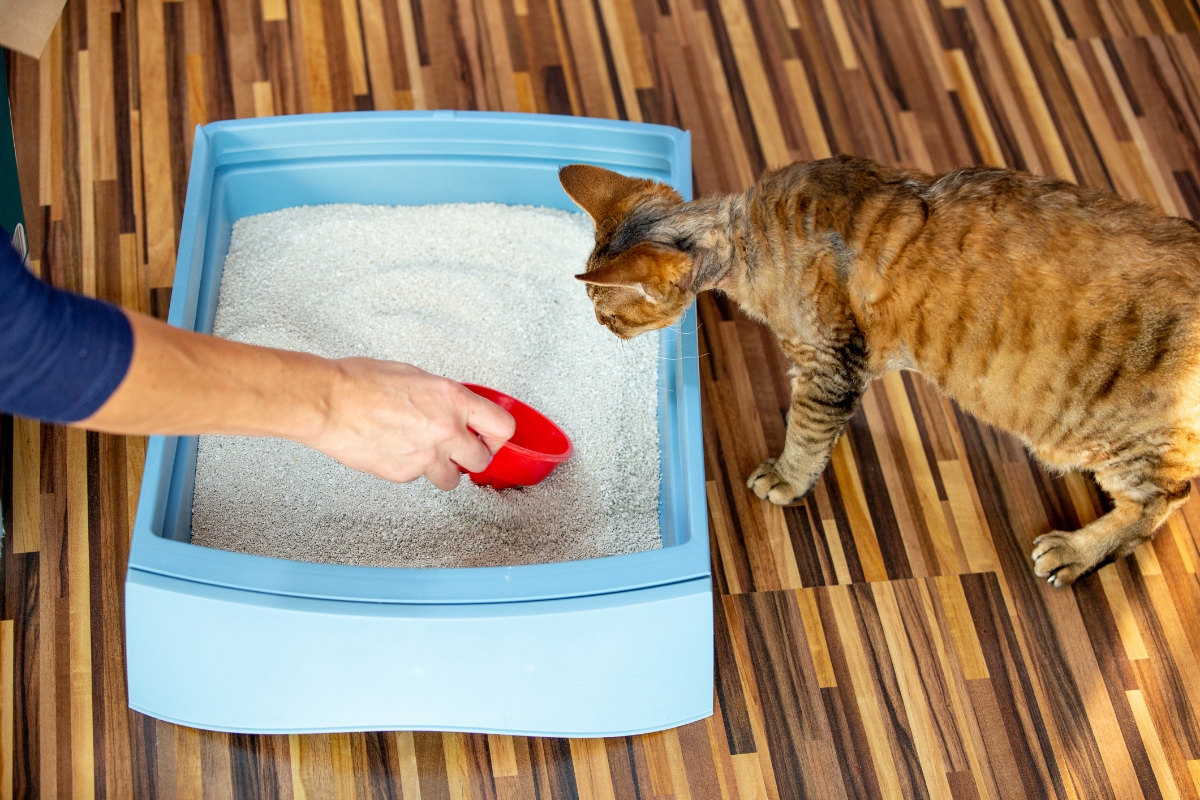Table of Contents
We typically have limited opportunities to assess our cats’ urine. When our cats use the litterbox, the urine is absorbed by litter that masks its appearance. However, if your cat urinates outside the litterbox, especially on a light-colored surface, you may be able to see their urine more closely. Sometimes, you might notice a blood-tinged color to the urine. This can indicate a health problem, and it’s important to take action.
What should you do if you suspect there is blood in your cat’s urine? Read on to learn more.
Can you see blood in a cat’s urine?
Normal cat urine varies from pale yellow to dark yellow or orange in color. The color of your cat’s urine will depend on their water intake, their kidney function, and other factors.
If your cat’s urine takes on a red color, this suggests that there may be blood in the urine. Bloody urine, or hematuria, is caused by bleeding in the urinary tract. There are multiple causes of hematuria; some of these conditions are mild, while others are severe.
Blood in the urine isn’t always visible to the naked eye. Mild hematuria can only be detected by veterinary testing. However, even mild hematuria may be accompanied by clinical signs of urinary tract disease. Affected cats may strain to urinate, spend more time in the litterbox, or urinate outside of the litterbox. Any of these signs can suggest urinary tract disease, and cats with urinary tract disease are more likely to have hematuria.
How do veterinarians detect blood in the urine?
Small amounts of blood in the urine may not cause an obvious color change. Veterinarians detect mild hematuria by performing a urinalysis (urine analysis).
There are two components of a urinalysis that detect blood in the urine:
- Urine biochemical analysis: This test uses a chemical test strip to screen for various substances in your cat’s urine, including blood.
- Microscopic sediment exam: In this test, a member of the veterinary team will spin a sample of your cat’s urine at high speed in a centrifuge. Cells or debris in your cat’s urine will fall to the bottom of the sample as a concentrated pellet. This pellet is examined under a microscope. If there are red blood cells in the pellet, the cat is diagnosed with hematuria.
What causes blood in the urine?
There are multiple causes of hematuria in cats, including:
- Urinary stones: Minerals in the urine can collect into microscopic crystals, which come together to form larger stones. These stones usually form in the bladder, although kidney stones can also occur. Urinary stones rub against tissue, causing trauma and hematuria.
- Bacterial infection: Urinary tract infections cause significant inflammation within the bladder and urinary tract. This can lead to hematuria.
- Bladder tumor: Bleeding tumors in the urinary tract are an uncommon cause of hematuria. This condition is rare, affecting approximately 1 in 1,000 cats.
- Feline idiopathic cystitis (FIC): This condition refers to bladder inflammation with no identifiable cause. Affected cats have clinical signs of urinary tract disease (straining, urinating outside the litterbox, hematuria etc.), but no underlying cause can be found.
How will my veterinarian diagnose the cause of my cat’s hematuria?
Your veterinarian may perform multiple tests to figure out what is causing blood in your cat’s urine.
After confirming the presence of hematuria using a urinalysis, further testing may include:
- Blood tests: Although blood tests are not specific for any of the causes of hematuria, they give your veterinarian a good picture of your cat’s overall health. Blood tests also help your veterinarian evaluate your cat’s kidney function.
- Urine culture and sensitivity: This is the most accurate way to diagnose urinary tract infections in cats.
- X-rays: Many feline bladder stones are visible with x-ray imaging.
- Ultrasound: This test provides a closer look at the inside of the bladder. It is not recommended for every cat, but it may be used to rule out bladder stones and tumors in high-risk cats.
How will my veterinarian treat blood in the urine?
Treatment will depend on the underlying cause of your cat’s hematuria. An accurate diagnosis is essential so your veterinarian can create an appropriate treatment plan.
The most common cause of hematuria in cats is FIC. Your veterinarian will diagnose FIC after ruling out other potential causes of your cat’s hematuria. Episodes of FIC may resolve on their own within a week or two; if that happens, no treatment is needed. If signs of FIC persist or recur, though, treatment often focuses on urine dilution and stress reduction. First, your veterinarian may recommend increasing your cat’s water intake, using canned food or a running water fountain. Your veterinarian may also prescribe medications and/or prescription diets to aid in managing your cat’s clinical signs. Finally, you will need to focus on reducing potential stressors for your cat.
Stress-reduction measures for cats with FIC may include:
- Address inter-cat conflict (in multi-cat homes)
- Increase play/activity
- Keep routines predictable
- Increase access to perches, scratching posts, and resting places
- Keep litterboxes clean and easily accessible
- Allow limited, controlled outdoor access using a screened porch, “catio,” or leash walks
- Use calming pheromones, such as Feliway®
The treatment of bladder stones varies depending on the type of stone present. Some bladder stones dissolve with a prescription diet. If your cat’s stones are dissolvable, your veterinarian will prescribe a suitable diet and recommend regular x-rays for monitoring. If your cat’s bladder stones can’t be dissolved with diet, surgery is often recommended. This surgery, called a cystotomy, involves surgically opening the bladder to remove the stones.
Although urinary tract infections (UTIs) are not common in cats, they can occur. They are more likely in older cats and in cats with underlying medical conditions (such as diabetes or kidney disease). Treatment requires antibiotics, which must be given as directed. Stopping antibiotics too early can increase the risk of antibiotic resistance.
Bladder tumors are rare in cats, fortunately. However, they can occur. These tumors are typically treated with anti-inflammatory drugs and/or chemotherapy. Less commonly, surgery and/or radiation may be recommended for cats with bladder tumors.
Summary
Hematuria, or blood in the urine, can be detected by cat owners or by veterinarians. There are multiple causes of hematuria, each of which requires a unique approach to treatment. If you see signs of blood in your cat’s urine, schedule a veterinary appointment as soon as possible. Your veterinarian can figure out an accurate diagnosis and then recommend the best treatment for your cat.








